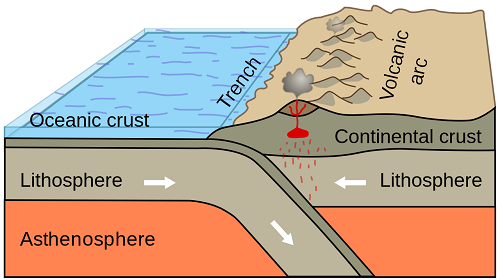The lithosphere and asthenosphere are two critical components of the Earth’s uppermost layer, known as the Earth’s upper mantle and crust. They have distinct characteristics and play essential roles in the Earth’s geological processes.

Lithosphere:
- The lithosphere is the rigid, outermost layer of the Earth’s structure. It consists of the Earth’s crust and the uppermost portion of the mantle.
- Composition: The lithosphere is primarily composed of solid rock, including both the Earth’s continental and oceanic crusts and the underlying, cooler, and less ductile portion of the upper mantle.
- Thickness: The thickness of the lithosphere varies significantly. Continental lithosphere is generally thicker (up to 100 kilometers or 62 miles) than oceanic lithosphere (typically around 7 to 10 kilometers or 4 to 6 miles).
- Behavior: The lithosphere behaves as a rigid, brittle shell that is divided into several tectonic plates. These plates can move and interact with each other along their boundaries, leading to geological phenomena such as earthquakes, volcanic activity, and the formation of mountain ranges.
Asthenosphere:
- The asthenosphere is a semi-fluid, partially molten layer that lies just beneath the lithosphere.
- Composition: The asthenosphere is primarily composed of solid rock that is under extremely high temperatures and pressures. However, it is partially molten, meaning that it contains small pockets of molten material or “partial melts.”
- Behavior: Unlike the rigid lithosphere, the asthenosphere is capable of flowing and deforming over geological time scales. This property is due to the elevated temperature and the presence of partial melts, which decrease the rock’s strength and allow it to flow slowly.
- Role in Plate Tectonics: The asthenosphere is critical to the process of plate tectonics. The movement of tectonic plates, driven by convection currents in the partially molten asthenosphere, is what causes the lithosphere to move and interact along plate boundaries. This movement is responsible for the shifting of continents, the creation of ocean basins, and the occurrence of geological features like mid-ocean ridges and subduction zones.
In summary, the lithosphere is the rigid, outermost layer of the Earth, consisting of the crust and the uppermost mantle. It is divided into tectonic plates and plays a crucial role in plate tectonics. Below the lithosphere, the asthenosphere is a semi-fluid layer that allows for the movement of tectonic plates due to its semi-molten nature. Together, these layers are responsible for shaping the Earth’s surface and driving geological processes.

Comparison of the lithosphere and asthenosphere:
| Feature | Lithosphere | Asthenosphere |
|---|---|---|
| Location | Outermost layer of the Earth | Beneath the lithosphere |
| Composition | Rigid and solid | Semi-fluid and partially molten |
| Components | Includes the Earth’s crust and | Comprises the upper part of the |
| uppermost part of the mantle | mantle | |
| State | Solid | Semi-fluid |
| Depth | Extends from the Earth’s surface | Extends from beneath the |
| to varying depths beneath the | lithosphere to about 700 kilometers | |
| surface | below the Earth’s surface | |
| Tectonic Plates | Divided into tectonic plates | Tectonic plates float on the |
| semi-fluid asthenosphere | ||
| Geological Processes | Involved in earthquakes, volcanic | Convection currents in the |
| activity, and the formation of | asthenosphere drive the lateral | |
| tectonic features | movement of tectonic plates |
This table summarizes the key characteristics and distinctions between the lithosphere and asthenosphere.